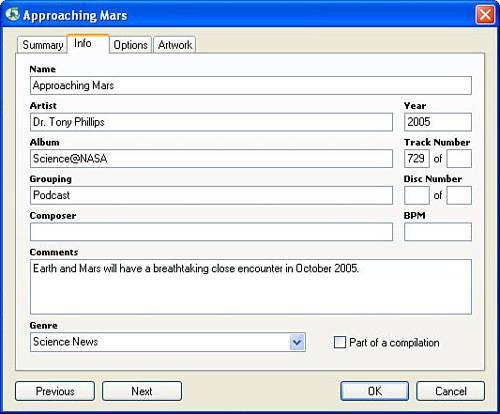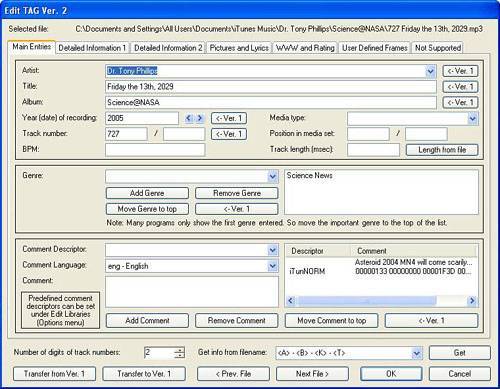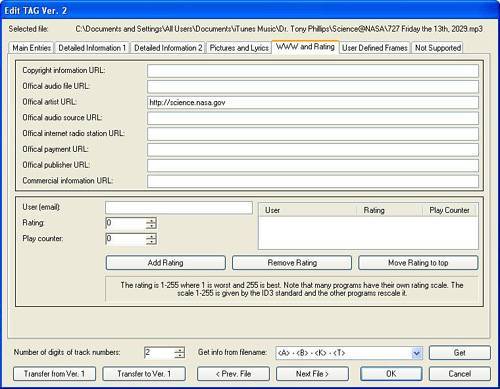What You Need to Know About ID3 Tags
| The MP3 standard is pretty good at storing recorded music information. In its original form, though, it didn't have the ability to store any information about the recordingno facilities for carrying title, artist, album, date, or any of the other facts we use to organize the recordings in our collection. Think about itthere was, in the original specification, no way to identify the file and its contents except through the name of the file. Fortunately, there were, pretty quickly following the development of the spec, those who recognized the need for some system to organize files, and ID3 was born. In the original ID3V1 specification, there were fixed lengths and locations for the information, which was limited in scope and contents. These limitations were addressed in ID3V2, which became the version of ID3 tags used by most MP3 players and software. The only reason to think about ID3V1 is that there are still some users with software that can only read the older tags; if you want the maximum compatibility and can live with the limitations of the earlier version, you can specify ID3V1 when you're writing your final podcast file. It's possible, in fact, to use both, and many people do in order to cover the greatest number of users. Most ID3 tag editors clearly show which tags are used in a particular specification, and there are many fewer tags to worry about in ID3V1. For the rest of this section, we'll assume that you're going to use ID3V2 for your podcasts. When you look at an MP3 player, the screen generally shows the name of the song, the album, and the artist, and may include additional information such as genre and the art from the album cover. You can often look at this same information in the software you use to link the MP3 player with a personal computer; Figure 8.16 shows a screen containing ID3 tags (or information) in Apple's iTunes software. File 8.16. ID3 tags can be viewed with iTunes. It's possible to use a product such as iTunes to edit the ID3 tags for your podcast before you upload it to your website. Most podcast recording software allows you to edit the tags when you're making the original recording or creating the edited file prior to upload. Figure 8.17 shows the menu for creating ID3 tags in iPodcast Producer. Notice that there are many fields that you can provide information for; in just a moment, we'll look at how you should fill those in. Before we do, though, let's look at one more option for providing ID3 information. Figure 8.17. Podcast creation software allows you to create ID3 tags. There are a number of shareware, open-source, GPL, and commercial products that are ID3 tag editors. With these editors, it is generally possible to edit many more of the parameters that exist in ID3V2 tags than are accessible through most recording, podcast production, or MP3-player synchronization programs. One such program is ID3-TagIT, a free software package developed by Michael Pluemper. The screenshots in Figure 8.18 were taken from ID3-Tagit as it manipulated the ID3 tags for the Science@NASA podcast. Note how rich the options are for including information in the ID3 tagsinformation that can be used for organizing, finding, and using your podcast. Figure 8.18a. ID3V2 allows many tags to be established. Figure 8.18b. Figure 8.18c. Figure 8.18d. With the options for how to edit ID3 tags covered, the question moves to "What should the ID3 tags say?" Here is where things get interesting for you, and your podcast gets considerably more (or less) interesting for your listeners. First, know that we're fans of complete information in the ID3 tags. It takes only a moment or two to fully populate the critical tag fields, and the information is valuable to any listener who wants to organize his MP3 files or find a particular file (like yours) based on something besides your name. Making Tags More UsefulThe first and most important factor to make your tags useful to your listeners is to be consistent. Remember that the sorting and searching is being done by a computer, so if you make changes to your name (adding a middle initial sometimes, or using Liz instead of Elizabeth a time or two) then the computer will see two different authors. By the same token, changing the name of your podcast, or changing the way you number your podcasts, makes a huge difference. Do you want to sequentially number your podcast ("This is podcast number 14"), or refer to your podcast by date? It's a little thing, but consistent numbering makes it possible to see all the podcasts in order on an MP3-player playlist. The same is true of the "Album" field, which you should generally use to refer to your podcasts as a collection, with each individual podcast playing the role of a "track" on an album. There are some conventions that have been picked up by podcasters that will make things easier for your listeners. Under "Artist," you should list your name onlyyour guests (if any) can go into a notes field. The "Album" name is the name of your podcast, which should not change from recording to recording. "Track Number," on the other hand, should change each time, increasing by one with each new episode. You should also choose a genre, whether "spoken" or "podcast," that you keep consistent between recordings. Keeping these tags the same from one recording to another (with the exception of the "Track Number" tag) will help your listener organize podcasts and find the specific show she's looking for. She will appreciate this thoughtfulness on your part, tell her friends how wonderful you are, and generally help promote your podcast far and wide. As you're naming your podcast, you can be quite creative, but remember that many MP3 players have a limited number of characters that can be displayed at one time. Some iPod models, for instance, can display 19 characters at a time. While the display will generally begin to scroll when an MP3 player's "cursor" is on a track title, the first few characters are what the user will see when scrolling through a playlist. You'll want to be careful how you choose the first dozen or so characters of your podcast's name to make it easy to find among hundreds of files on an MP3 player. Once you've decided on a plan for ID3 tags and edited the tags on your completed podcast, it's time to upload it to a hosting site. In most cases, that will mean using software that understands FTP. |
EAN: N/A
Pages: 167